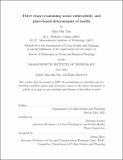Three essays examining social vulnerability and place-based determinants of health
Author(s)
Tan, Shin Bin
DownloadThesis PDF (11.22Mb)
Advisor
Mariana Arcaya
Terms of use
Metadata
Show full item recordAbstract
This three-essay dissertation examines how different environmental characteristics might support better health and economic outcomes of socially vulnerable individuals, with a focus on the role policy and planning can play. The first essay focuses on community resilience – the capability that helps communities resist, absorb and recover from disasters and traumas. I empirically examine how well a community resilience assessment tool developed by the U.S. Federal Emergency Management Agency (FEMA) predicts post-disaster, county and individual-level health outcomes and find concerning shortfalls. Using FEMA’s tool as an illustrative case, I highlight limitations of current efforts to quantify community resilience via indicator-based assessment tools, and propose possible improvements to policy-based community assessment tools. The second essay examines whether disaster-induced residential relocation to ‘higher economic opportunity’ areas might support better post-disaster outcomes. Using a mixed-methods approach to analyze repeated survey data and interviews of low-income mothers hit by the 2005 Hurricane Katrina, this study found a unit increase in year-weighted county opportunity predicted a doubling of incomes approximately 12 years after the hurricane, but only if participants remained in higher opportunity counties beyond 9 to 21 months. Living in higher opportunity areas however was not associated with better long-term health, potentially because of the challenges integrating into a new area post-disaster, which suggests the need for additional support to help disaster survivors sustain residence in higher opportunity areas. The third essay examines how accumulated exposures to obesogenic neighbourhood environments affect children and mothers’ BMI, and how socioeconomic status might modify such neighbourhood effects. Drawing from a mother-child birth cohort study based in Singapore, this study found that socioeconomic vulnerability modified the relationship between exposure to specific obesogenic neighborhood characteristics and BMI-related outcomes, such that increased access to bus-stops and park connectors predicted a drop in BMI outcomes for higher SES children and mothers respectively, but an increase for lower SES individuals. Study results emphasize the importance of considering how urban interventions might have heterogenous effects by SES.
Date issued
2021-06Department
Massachusetts Institute of Technology. Department of Urban Studies and PlanningPublisher
Massachusetts Institute of Technology